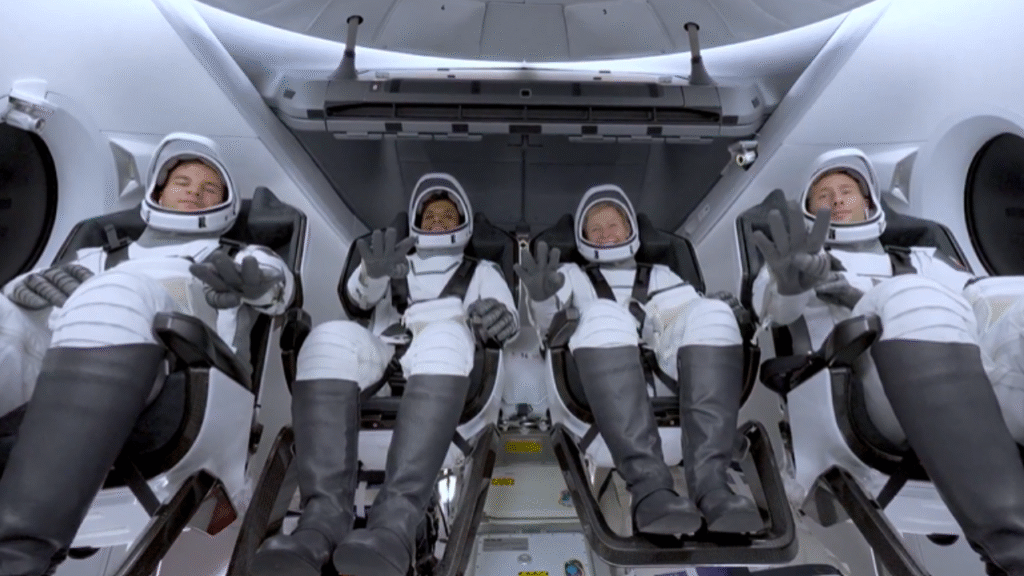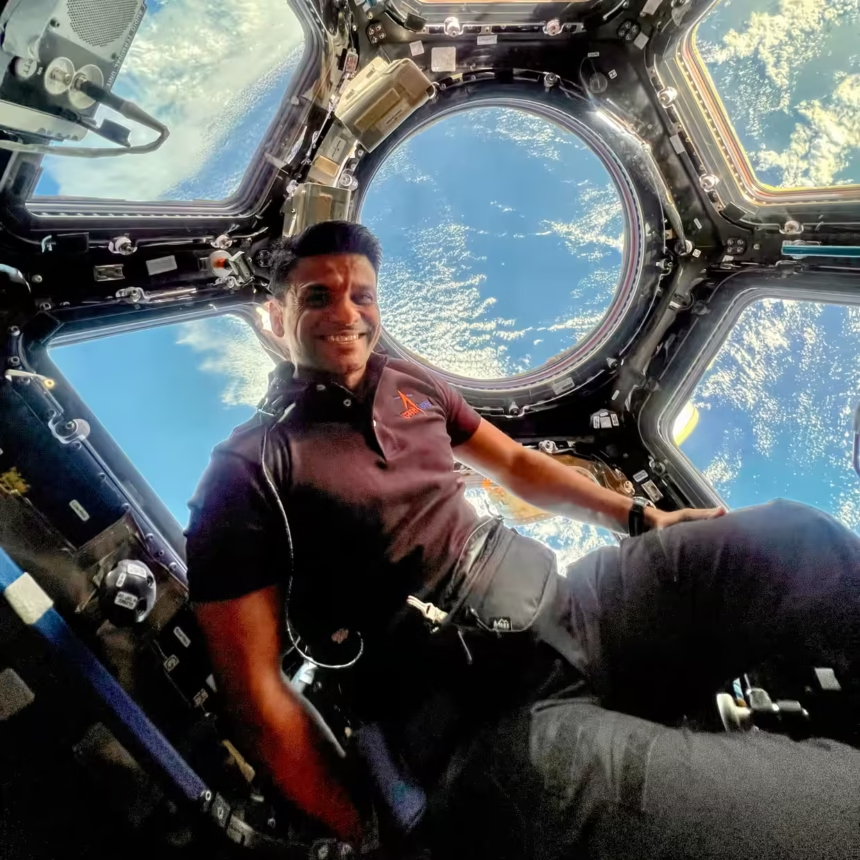India’s Return to Space — A Historic Journey to the International Space Station
In a defining moment for India’s scientific and strategic ambitions, the country has sent its first astronaut to the International Space Station (ISS) in four decades, marking not just a technological leap but a symbolic reaffirmation of its place in the global space community. The mission, quietly prepared over years of technical coordination and international diplomacy, has reignited public imagination and underscored India’s commitment to peaceful space exploration in a geopolitically turbulent world.
The Indian astronaut, Wing Commander Rajeev Joshi, a decorated Indian Air Force pilot and aerospace engineer, lifted off aboard a multinational crew capsule in collaboration with NASA and the European Space Agency (ESA). His arrival at the ISS—amid cheers from mission control and millions watching across India—was not merely the culmination of a single mission, but the result of over a decade of planning, diplomacy, and investment into what is now being termed as the second space age for India.
This mission carries with it not only the hopes of the scientific community but also the weight of forty years of waiting since Rakesh Sharma, India’s first astronaut, flew aboard the Soviet Soyuz T-11 mission in 1984. Since then, India’s space program has focused on satellite launches, deep space probes, and lunar and Martian missions through its premier agency, ISRO (Indian Space Research Organisation). But the absence of a human spaceflight presence remained a conspicuous gap in an otherwise robust record of accomplishments.
Rajeev Joshi’s journey changes that.
What makes this mission particularly historic is its broader context. In an era where private players like SpaceX and Blue Origin dominate headlines, and China and the U.S. compete over lunar dominance, India’s approach remains measured, multilateral, and deeply science-driven. The inclusion of Indian personnel aboard the ISS comes not from political flexing but from scientific partnerships—formed through memoranda of understanding, crew training exchanges, and shared goals around climate observation, microgravity research, and technology validation in orbit.
Back home, the announcement sparked a wave of national pride. From school science classrooms in rural Bihar to digital billboards lighting up Delhi and Bengaluru, the message was loud and clear: India is back in human spaceflight.
But this achievement is not just about prestige. It is about practical outcomes. The experiments that Rajeev Joshi will conduct—ranging from bio-regenerative life support systems to microgravity impacts on cardiovascular function—have direct implications for Earth-based medicine, climate modeling, and long-duration space travel. His mission is part of a larger Indian strategy to integrate space-based solutions into public welfare systems, whether through weather forecasting, disaster response, or agriculture monitoring.

Additionally, his presence at the ISS represents a diplomatic milestone. India is now a participant in the Artemis Accords, an international framework that outlines peaceful exploration and sustainable use of outer space. With this, India steps into a more influential role, ensuring it has a voice in shaping the future of extraterrestrial norms, space station replacements, and lunar governance.
The human story, however, is just as compelling as the technological one. Rajeev Joshi, who once flew MiG-21s over the Himalayas, is now orbiting 400 kilometers above Earth. His training was nothing short of grueling—months in neutral buoyancy labs, hypobaric chambers, survival tests in deserts and oceans, and intense language immersion for communication aboard an international platform. He is, by all definitions, a product of Indian excellence and global cooperation.
As India watches his progress with bated breath, his words upon entering the ISS—“India has arrived, respectfully and responsibly”—are likely to be etched into history.
To truly appreciate the significance of Wing Commander Rajeev Joshi’s presence aboard the International Space Station in 2025, one must revisit the legacy of India’s first spacefarer, Rakesh Sharma, who in 1984 became the face of Indian pride and potential in outer space. His mission aboard Soyuz T-11, conducted in cooperation with the Soviet Union, made India only the fourth nation to send a human to space. Yet what followed was not a surge in astronaut missions, but a long, perplexing silence.
For four decades, India pursued space science with vigor—just not with astronauts.
From the mid-1980s to the 2010s, the Indian Space Research Organisation (ISRO) focused its efforts almost exclusively on remote sensing, satellite deployment, and planetary exploration. This was by design, not neglect. The Indian government, particularly during the liberalization era of the 1990s, prioritized cost-effective, utilitarian space missions—those that could support communication, agriculture, weather forecasting, and navigation.
And they succeeded. India launched over a hundred satellites, placed missions in lunar and Martian orbits, and became a reliable launch service provider to more than 30 countries. ISRO’s cost-efficiency became legendary, and its mission successes, such as Chandrayaan-1 (2008), Mars Orbiter Mission (2013), and Chandrayaan-3 (2023), proved that India could be a serious space contender.
But through all of this, human spaceflight was relegated to the realm of nationalistic aspiration—promised on paper, but never fully funded.
The reasons were manifold. Human spaceflight requires a massive investment in infrastructure, crew training, life support systems, capsule recovery, ground control redundancies, and decades of design validation. More importantly, it requires long-term political commitment, across administrations—something India, like many democracies, found hard to guarantee.
The Gaganyaan program, announced in 2007, was India’s first formal effort to build an indigenous human spaceflight capability. Initially, progress was slow—partly due to budgetary constraints, partly due to shifting political priorities. The real momentum came post-2018, when Prime Minister Narendra Modi declared that an Indian astronaut would fly aboard an Indian spacecraft by 2022. The announcement gave Gaganyaan a national spotlight—and a budget boost.
But the program faced setbacks, including technical delays and the COVID-19 pandemic, which disrupted supply chains and testing schedules. As a result, the original deadline slipped, and India had to reconsider its path. That reconsideration led to a strategic pivot—instead of rushing a crewed mission aboard an indigenous spacecraft, India would first train astronauts abroad and place them on international platforms, building experience and credibility along the way.
This pivot bore fruit in 2023 when ISRO signed a framework with NASA and the European Space Agency (ESA) for astronaut exchange and joint research missions. It was under this framework that Rajeev Joshi was selected, trained, and finally launched aboard a collaborative ISS mission in 2025.
In many ways, his presence aboard the ISS is Gaganyaan 0.5—not an Indian-built launch, but a crucial bridge toward one. It serves as a confidence-building measure for the Indian space ecosystem, from mission controllers to aerospace engineers, proving that Indian astronauts can be part of elite global crews under high-stakes operations.
Importantly, the mission has rekindled public interest in space travel—especially among India’s youth. University outreach programs, ISRO internships, and STEM education campaigns have surged in popularity. For the first time since 1984, Indian students once again aspire not just to build satellites, but to ride them.
Sending an astronaut into space is not simply about launching a human aboard a rocket; it’s about ensuring that person has the intellectual discipline, physical resilience, emotional intelligence, and technical expertise to survive, adapt, and excel in the most hostile environment known to humankind. For Wing Commander Rajeev Joshi, this journey from fighter pilot to India’s first astronaut in four decades was a crucible of transformation—grueling, meticulous, and deeply collaborative.
The story of Rajeev Joshi’s selection began not in a flashy auditorium or televised announcement but in the quiet confines of an Indian Air Force (IAF) selection board, where profiles of top-performing test pilots and aeronautical engineers were quietly assessed against a stringent set of requirements provided by ISRO, in consultation with international partners.
Rajeev, a decorated MiG-21 pilot and aerospace engineer, stood out for a unique combination of qualities: over 2,000 flight hours, experience in high-altitude survival operations, a master’s degree in flight systems, and an exceptional record of psychological stability during critical missions. But even with his decorated background, the road to becoming an astronaut was far from assured.
In 2022, he and three other shortlisted candidates were sent to Russia’s Gagarin Cosmonaut Training Center, under an agreement with Roscosmos to initiate India’s human spaceflight capability through legacy expertise. There, Rajeev underwent basic astronaut training—centrifuge spins to simulate high-G forces, zero-gravity parabolas aboard aircraft, pressure chamber resilience, and emergency water landing procedures.
He excelled across modules, but his standout performance came during neutral buoyancy training, which simulates weightlessness underwater. Instructors reported his calm, methodical approach to simulated ISS tasks, such as fixing mock circuit panels and handling precision tools under pressure. It was clear: he was not just capable, he was exceptional.
After his initial training in Russia, Rajeev returned to India for ISRO’s advanced protocols, including space medicine, environmental control systems, and capsule recovery simulations off the Indian coast. The Naval Physical and Oceanographic Laboratory (NPOL) conducted mock sea landings where Rajeev practiced escaping a sealed capsule, swimming to a life raft, and surviving up to 72 hours at sea with minimal provisions.
To adapt him for long-duration international missions, ISRO then transferred him to NASA’s Johnson Space Center in Houston, where he was integrated into multinational mission simulations. Here, language and coordination became as critical as physical readiness. Rajeev trained alongside American, European, and Japanese astronauts, learning ISS-specific tools, robotics, onboard systems, and emergency drills.
Every detail was scrutinized—his cardiac rhythm under stress, his sleep pattern after artificial day-night cycles, his reaction time during simulated depressurization events, and even his ability to work with crewmates from vastly different cultures. Unlike robotic missions, space station life is deeply interpersonal. Psychological compatibility and composure are as important as technical skill.
By 2024, NASA officially cleared Rajeev for full integration into an ISS rotation mission, citing his “superior operational competence and cultural adaptability.” His selection was endorsed by both ESA and Roscosmos—a rare achievement for a first-time astronaut from a non-partner country.
In his own words, shared during a pre-launch press conference, Rajeev said:
“You don’t become an astronaut the day you lift off. You become one the day you are trusted to represent your nation, its science, and its values in space. Every training session, every simulation, every drop of sweat is part of that responsibility.”
For ISRO and India, Rajeev Joshi is not just an astronaut; he is the embodiment of two decades of planning, the global credibility India has earned, and the intellectual power that defines its scientific community.
As Wing Commander Rajeev Joshi settles into the International Space Station, his mission enters its most critical phase: the execution of a complex series of scientific experiments, many of which are designed and funded by Indian research institutions in partnership with global collaborators. Unlike symbolic flights of the past, this mission is anchored in deliverables—onboard studies that bridge space science with societal benefits back home.
The mission carries over 14 active experiment modules, six of which originate directly from Indian research labs and universities, spanning fields as diverse as biomedicine, space agriculture, atmospheric physics, and fluid dynamics. The agenda is clear: maximize every minute in microgravity to unlock answers that can’t be found on Earth.
Microgravity and Human Health: Redefining Medicine
One of the most ambitious tasks assigned to Rajeev Joshi involves studying the long-term impact of microgravity on cardiovascular efficiency, a project jointly led by the All India Institute of Medical Sciences (AIIMS) and the Indian Institute of Science (IISc). The experiment, known as Cardio-GeoISRO, tracks changes in blood circulation, cardiac rhythm, and blood viscosity over weeks in zero gravity.
This study has profound implications. Understanding how the human body adapts to gravitational loss can reveal hidden stress patterns in heart disease, potentially leading to improved diagnostic models on Earth—especially for astronauts, pilots, and patients with circulatory disorders.
Cancer Cell Behavior in Zero-G: Targeted Research from Tata Memorial
Another vital experiment aboard the ISS is Onco-Gravity, designed by researchers at Tata Memorial Centre, Mumbai. Using microfluidic chambers, the team is monitoring how aggressive cancer cells behave without gravitational constraints, especially in how they migrate, cluster, and resist drug treatments.
In space, cancer cells often behave more aggressively and uniquely, providing insights that conventional petri dish labs on Earth can’t match. The research is intended to uncover new pathways for drug targeting—a potential game-changer in chemotherapy resistance.
Space Agriculture: Growing Food for Earth and Beyond
India is also testing its first attempt at space-based vertical farming, with a prototype unit called KrishiSat-01, co-developed by ISRO and IIT-Kharagpur. The system uses recycled water, LED-based lighting, and nano-nutrient packs to grow amaranth and fenugreek—plants chosen for their fast growth cycles and high nutritional density.
Success in this field would be a major breakthrough not just for future deep space missions but also for climate-vulnerable regions in India where soil degradation and water scarcity threaten food security.
. Materials Science: The Alloy Crystal Growth Project
India’s National Metallurgical Laboratory (NML) has contributed a payload to study the formation of novel metal alloys in the absence of gravity. Crystals grown in microgravity exhibit fewer imperfections, offering insights into lightweight, high-performance materials needed in aerospace, automotive, and defense applications.
Rajeev Joshi has been tasked with initiating the crystal seed growth, monitoring thermal gradients, and logging formation anomalies. Data from this experiment could help ISRO develop heat-shielding components for future spacecraft, including Gaganyaan.
. Atmospheric Research: Edge of Earth Observations
While much of his work is inside the station, Rajeev also participates in Earth observation missions, particularly focusing on the Indian subcontinent’s atmospheric layer—tracking aerosol dispersion, thunderstorm patterns, and monsoon behavior. These are part of a collaborative research initiative with NASA’s Earth Sciences Division and ISRO’s Atmospheric and Oceanic Sciences Programme.
This research ties into India’s climate resilience strategies, offering improved early warning systems for cyclones, heatwaves, and unpredictable monsoon activity.
Beyond the experiments themselves, Rajeev’s daily schedule is a masterclass in astronaut efficiency: 16-hour rotations packed with station maintenance, scientific procedures, physical fitness regimens, mission reporting, and communication with schoolchildren and scientists back home. He represents not just a national achievement but also a living laboratory, executing experiments that could shape policies, technologies, and treatments across multiple sectors.
Importantly, this is the first time Indian-designed experiments are being run independently by an Indian astronaut on a foreign space station, elevating India’s role from partner to direct contributor in orbital science.
The successful entry of Wing Commander Rajeev Joshi into the International Space Station may appear on the surface to be a scientific achievement—but beneath that triumph lies a story deeply entrenched in strategic diplomacy, soft power, and global space politics. As India reclaims its place in human spaceflight after 40 years, it does so not just as a participant, but as a country reshaping the contours of international cooperation and strategic autonomy in outer space.
Space exploration has always been about more than science. From the Cold War rivalry between the U.S. and the Soviet Union to China’s lunar ambitions and the Artemis Accords, space is a stage where nations project technological credibility, diplomatic intent, and ideological values. By returning a human to orbit, India signals not only that it has the scientific capacity to compete, but also that it seeks a seat at the space governance table of the 21st century.
India and the West: Strengthening Strategic Partnerships
Rajeev Joshi’s training and launch were made possible by unprecedented collaboration between ISRO, NASA, and the European Space Agency. This would have been unthinkable even a decade ago when India’s space program operated largely in isolation, often wary of Western oversight and intellectual property sharing. However, India’s gradual alignment with the U.S.-led space ecosystem—including its recent signing of the Artemis Accords—has opened new pathways for crew exchanges, joint research, and mission coordination.
This shift has strategic undercurrents. In an era where technology access is power, India’s cooperation with Western agencies signals mutual trust and alignment in future deep-space missions, especially those targeting the Moon and Mars. The U.S. sees India as a democratic, stable, and technically mature partner in Asia—a necessary counterbalance to China’s rapidly expanding space presence.
India, in turn, benefits from access to advanced space medicine, reusable spacecraft design, deep-space telemetry, and mission assurance frameworks that would take decades to develop independently.
China’s Shadow: A Quiet Rivalry Beyond the Atmosphere
India’s human spaceflight revival also carries a clear, if unspoken, geopolitical subtext vis-à-vis China. In 2003, China became the third nation to independently launch a human into space and has since built its own modular Tiangong Space Station, after being excluded from the ISS. Since then, it has performed multiple crewed missions, executed spacewalks, and laid the foundation for a permanent lunar base.
India, while publicly avoiding rhetoric around competition, has clearly sought to reclaim parity in space visibility and influence. Though Gaganyaan—India’s indigenous crewed spacecraft—is still under development, Rajeev Joshi’s mission ensures that India is not absent from the human presence in orbit, maintaining relevance and technological readiness.
This is especially important as the ISS nears its decommissioning phase (expected around 2030), and the conversation shifts to the next generation of orbiting platforms. India’s demonstrated human presence in space ensures it will be part of that conversation.
Multilateralism and the Global South
India’s astronaut mission is also a message to the Global South—a demonstration that human spaceflight is not the sole domain of superpowers. As a country that launched its first satellite from a bullock cart and now places astronauts in orbit through partnership and perseverance, India’s space story resonates with nations seeking an inclusive model of scientific progress.
India has already begun exporting its space expertise through satellite launches, training programs, and mission consulting to countries across Africa, Southeast Asia, and Latin America. Rajeev Joshi’s mission adds human spaceflight capability to that offering. It’s a powerful form of technological diplomacy—projecting not only capability but also a collaborative, non-hegemonic approach to space development.
The Message to the Indian Diaspora and Domestic Audience
For India’s global diaspora, Rajeev Joshi’s mission evokes pride and reaffirms their homeland’s global stature. Indian-origin professionals are already deeply embedded in NASA, ESA, and private aerospace companies like SpaceX and Blue Origin. This mission reinforces that India itself is now a launchpad for excellence, not just a talent exporter.
Domestically, the government has used the mission to strengthen national unity and youth engagement in science. Speeches from political leaders have framed it as a symbol of Aatmanirbhar Bharat—a self-reliant India that dreams big, works with allies, and contributes solutions to global challenges.
In essence, Rajeev Joshi’s journey is more than personal; it is a projection of India’s strategic identity. As the world enters a new era of space competition and cooperation, India’s presence in low-Earth orbit reaffirms that it belongs to the small but vital group of nations that are not just reaching for the stars—but helping to define the rules of that reach.








